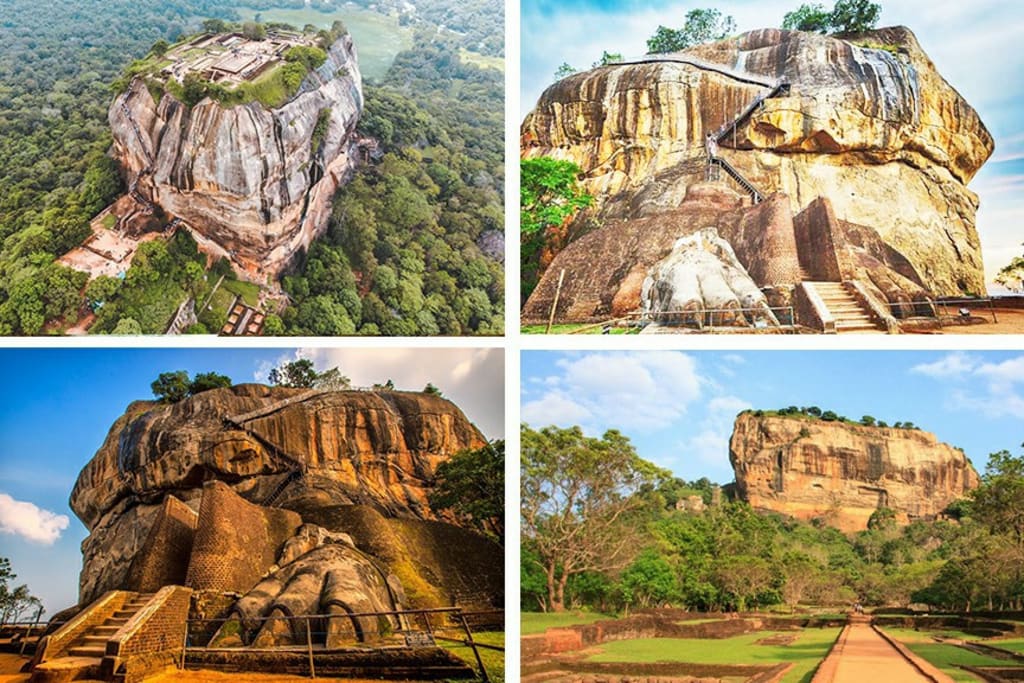The Mystery sigiriya
why the king kaasiyapa build this

Sigiriya, also known as Lion Rock, is a UNESCO World Heritage Site located in central Sri Lanka. The ancient fortress and palace complex is one of the most important archaeological sites in the country, and attracts thousands of visitors every year. The rock and its surrounding area are home to a rich history and cultural heritage, as well as stunning natural beauty.
The history of Sigiriya dates back to the 5th century AD, when King Kasyapa chose the rock as his capital and built a palace and fortress at the top. The king was known for his love of luxury and extravagance, and his palace was filled with beautiful gardens, fountains, and frescoes.
The rock fortress was designed as a defensive structure, with ramparts, moats, and water gardens protecting it from attack. The palace was built on top of the rock, with a complex system of staircases, walkways, and terraces leading up to it.
One of the most striking features of Sigiriya is the massive lion statue that once stood at the entrance to the palace. The statue was carved out of the rock itself, and visitors would enter the palace through the lion's mouth.
Today, the lion statue is no longer standing, but visitors can still climb to the top of the rock and explore the ruins of the palace and fortress. The climb is steep and can be challenging, but the views from the top are breathtaking. From the summit, visitors can see miles of lush green forests and hills, as well as the remains of the palace and gardens.
One of the most impressive features of Sigiriya is the series of frescoes that adorn the walls of the palace. The frescoes are believed to have been painted during the reign of King Kasyapa, and depict a range of subjects, including beautiful women, animals, and birds. The frescoes are considered to be some of the finest examples of ancient Sri Lankan art, and are a testament to the skill and craftsmanship of the artists who created them.
Another highlight of Sigiriya is the water gardens that surround the palace. The gardens are made up of a series of pools, fountains, and channels, and were designed to provide a cool and refreshing environment for the king and his courtiers. The gardens are still functional today, and visitors can see the intricate water systems that were used to create them.
In addition to its historical and cultural significance, Sigiriya is also an important natural landmark. The rock is surrounded by lush forests and is home to a diverse range of flora and fauna. Visitors can see monkeys, birds, and other wildlife as they make their way up to the palace.
Sigiriya is an important part of Sri Lanka's cultural heritage, and a visit to the rock is a must for anyone interested in the country's history and archaeology. The site is well-preserved and provides a fascinating glimpse into the ancient world of Sri Lanka's kings and queens. The climb to the top of the rock is challenging but rewarding, and the views from the summit are truly spectacular. Whether you are a history buff, nature lover, or just looking for a unique and unforgettable travel experience, Sigiriya is a destination that should not be missed
What are mysteries in sigriya

Sigiriya is a fascinating place, full of history and culture. Over the years, many mysteries and legends have emerged about the rock fortress and its surroundings. Here are some of the most intriguing mysteries of Sigiriya:
The Lion's Paw: One of the most mysterious features of Sigiriya is the giant lion statue that once guarded the entrance to the palace. The statue was carved out of the rock, but only the paws and a few other fragments remain today. The head of the lion has never been found, leading to speculation about what happened to it and why it was removed.
The Mirror Wall: The western face of Sigiriya's rock fortress is covered in a smooth, polished wall known as the Mirror Wall. The wall was once so reflective that it was said you could see your reflection in it, even from a distance. Over the centuries, visitors have written graffiti on the wall, which today provides a valuable record of the ancient visitors to the site. However, the wall also holds a mystery: it is said that the graffiti includes poems and inscriptions that were written in a language that has yet to be deciphered.
The Water Gardens: The water gardens of Sigiriya are a wonder of ancient engineering, with a complex system of channels, pools, and fountains that provided a cool and refreshing environment for the king and his court. However, the gardens also hold a mystery: it is said that there is a hidden underground chamber beneath one of the pools, which may have served as a secret escape route for the king in times of danger.
The Frescoes: The frescoes that adorn the walls of the palace are a highlight of Sigiriya, but they also hold a mystery. Some of the frescoes depict beautiful women, and it is believed that these women may have been the king's concubines or queens. However, there is no consensus among scholars about the identity of the women or the meaning behind the frescoes.
The Astronomy: Some scholars believe that the rock fortress of Sigiriya was not just a palace and fortress, but also a center for astronomical observation. The positioning of the palace and the layout of the water gardens suggest that the king and his courtiers may have been interested in observing the stars and planets.
These mysteries, and many more, continue to fascinate visitors to Sigiriya, and provide a rich and intriguing backdrop to the history and culture of this ancient site.
thank you!





Comments (1)
Thanks for sharing ❤